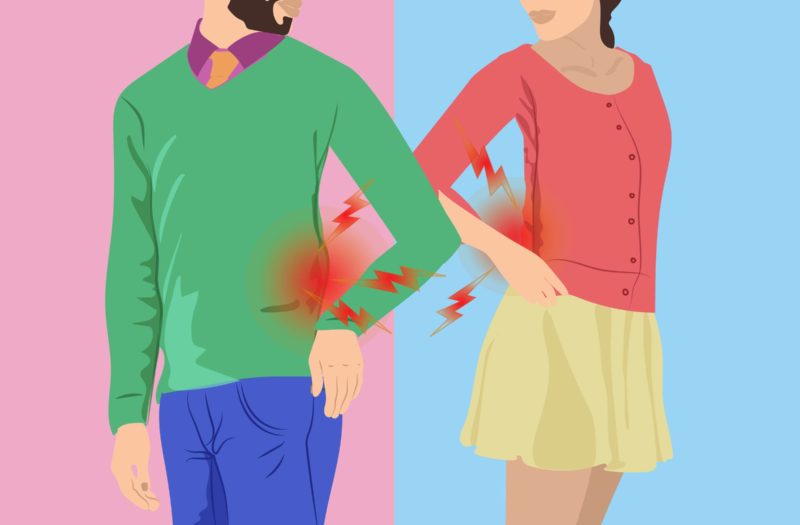Over the past two years, treatment options for non-radiographic axial spondyloarthritis (nr-axSpA) have notably expanded in the U.S.
In the spring of 2019, the U.S. Food and Drug Administration approved the first tumor necrosis factor (TNF) inhibitor, certolizumab pegol (Cimzia), for non-radiographic axial spondyloarthritis (nr-axSpA), but other drugs in this class have been used off-label for years to treat this condition. A year later, in the spring of 2020, two biologics that work on different parts of the immune system (both inhibit a protein called interleukin-17, or IL-17), were also approved for nr-axSpA: ixekizumab (Taltz) and secukinumab (Cosentyx).
Non-radiographic axial spondyloarthritis is a form of inflammatory arthritis that predominantly affects the spine and sacroiliac joints in the pelvis. It is thought to be on a spectrum of disease with the radiographic form of the condition, known as ankylosing spondylitis. While both conditions cause similar symptoms and disability, with, nr-axSpA, joint damage is not visible on X-rays. With ankylosing spondylitis, you can see damage to the sacroiliac joints on X-rays. The umbrella condition for both diseases is called axial spondyloarthritis.
Various studies have pointed to differences in symptoms, disease activity, and quality of life measures in men vs. women with axial spondyloarthritis, which in turn could impact the effectiveness of treatment.
For example, as MedPage Today reports, in people with ankylosing spondylitis, “women typically have higher self-reported disease activity, worse function, lower quality of life, and more peripheral arthritis and enthesitis. In contrast, men typically have higher levels of C-reactive protein (CRP) and more inflammation seen on magnetic resonance imaging.” Enthesitis is inflammation of tendons and ligaments that connect to bones, such as at the Achilles heel, elbow, or bottom of the foot.
However, less is known about sex differences in non-radiographic axial spondyloarthritis — and how they may impact how well treatment works.
A new study from Swiss researchers looked at men and women with nr-axSpA taking TNF inhibitors, which are a biologic medication that block a protein called tumor necrosis factor that leads to inflammation. Their findings suggest that these medications are less effective in women, but questions remain as to why this is the case.
The research, published in the journal Arthritis Research & Therapy, focused on a group of about 500 Swiss patients with nr-axSpA. They then narrowed the group further to 85 women and 78 men who did not have fibromyalgia, a chronic pain disorder that can co-occur in people with inflammatory arthritis such as nr-axSpA.
Fibromyalgia pain is due to different causes than those that cause non-radiographic axial spondyloarthritis and does not respond to biologic medications, which is likely why these patients were not included in this study.
When the study began, everyone in the study was starting a TNF inhibitor biologic for the first time. A year later, 38 percent of male patients had achieved a significant improvement in disease activity (as defined by the Assessment of SpondyloArthritis International Society criteria (ASAS40). In contrast, only 17 percent of women ended up hitting that disease activity improvement benchmark.
What could be responsible for this discrepancy in response to TNF medications between men and women non-radiographic axial spondyloarthritis patients?
At the start of the study, women had a slightly longer delay in getting diagnosed with non-radiographic axial spondyloarthritis (six years for women vs. 4.7 for men), a higher level of perceived disease activity, and more enthesitis compared with men. A lower percentage of women than men were positive for HLA-B27. HLA-B27 is a genetic variation that is associated with some inflammatory diseases, including axSpA. Women were also more
However, there were a number of similarities between men and women on other measures of disease, including measures of function, spinal mobility, quality of life, levels of C-reactive protein (an inflammatory marker in the blood), inflammation of peripheral joints (those other than the spine and pelvis), and dactylitis (swelling of fingers or toes).
“Despite these similarities between the genders in nr-axSpA, response to TNFi was significantly lower in women than in men,” they reported.
The researchers said they were not sure why men in this study seemed to respond to TNF inhibitors better but suggested that some women might have been misdiagnosed with nr-axSpA when they really had another problem such as fibromyalgia or edema (swelling) in their bone marrow following a pregnancy.
However, it’s clear that more research is needed to understand what could be driving potential sex differences in axSpA treatment effectiveness.
The researchers said their study adds to the available data to support the idea that future randomized controlled trials for medications in axial spondyloarthritis be designed so that they could detect potential sex differences.
Be a More Proactive Patient with ArthritisPower
Join CreakyJoints’ patient-centered research registry to track your symptoms, disease activity, and medications — and share with your doctor. Learn more and sign up here.
Neuenschwander R, et al. Differences between men and women with nonradiographic axial spondyloarthritis: clinical characteristics and treatment effectiveness in a real-life prospective cohort. Arthritis Research & Therapy. October 2020. doi: https://doi.org/10.1186/s13075-020-02337-2
Walsh N. Women Fare Worse in Treatment for Spine Disease. MedPage Today. October 15, 2020. https://www.medpagetoday.com/rheumatology/arthritis/89144.






